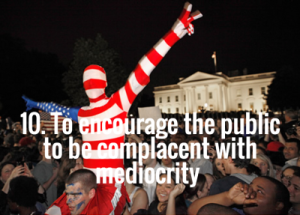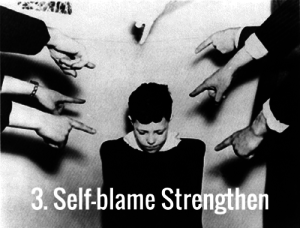Sleeping on the Streets: DOJ Challenges the Constitutionality of Anti-Homelessness Ordinances
by Nomad
Otherwise ignored by mainstream media, the Washington Post picked up an interesting news article the other day regarding homelessness and a DOJ challenge the local ordinances against vagancy.
To Be Without a Home, Like a Complete Unknown
Boise, like many US cities, passed an ordinance which banned sleeping or camping in public places. That city is by no means unique.
The usual knee-jerk reaction to a visible and embarrassing problem has been to find a way to make it a criminal offense. The idea is basically if we can’t prevent it, we can make it illegal and then we can make it invisible.
According to last year’s report from the National Law Center on Homelessness & Poverty, a survey of 187 cities found that:
- 24% of cities impose city-wide bans on begging in public.
- 76% of cities prohibit begging in particular public places.
- 33% of cities make it illegal to loiter in public throughout an entire city.
- 65% of cities prohibit the activity in particular public places.
- 53% of cities prohibit sitting or lying down in particular public places.
- 43% of cities prohibit sleeping in vehicles.
- 9% of cities prohibit sharing of food
A recent study by UC Berkeley School of Law noted that more Californian cities have enacted more anti-vagrancy laws than in any other part of the country. with Los Angeles and San Francisco topping the list.
The laws restrict anything from panhandling to sharing food with a homeless person to sitting in public spaces.
Some claim that the laws are applied in an arbitrary manner, targeting the poor.
Co-author of the study, Marina Fisher, feels the laws are discriminatory, stating that “you don’t hear about people camping at night to get the latest iPhone getting affected.”
As we shall see, the charge of arbitrary enforcement of these ordinances is a major problem.
The NLCHP report, “No Safe Place- The Criminalization of Homelessness in U.S. Cities“ noted:
Despite a lack of affordable housing and shelter space, many cities have chosen to criminally punish people living on the street for doing what any human being must do to survive.
The NLCHP, which filed the lawsuit against Boise, alleged that:
All of these laws criminalize the kind of activities — sitting, resting, sleeping — that are arguably fundamental to human existence.
When Surviving is an Offense
Last week, the Department of Justice seemed to agree and appears to be willing to challenge such laws in court.
The Department issued a statement of interest which argued that in passing such laws, the city of Boise (and other cities with similar laws) has effectively criminalized homelessness itself in situations where people simply have nowhere else to sleep.
Sleep, the document argues, is a necessity for survival for all of us. Despite that, many homeless people are simply not able to find safe and legal places to sleep. The federal government estimated that last year, there were some 153,000 unsheltered homeless on the street in the U.S. on any given night.
When shelters are inadequate, these individuals – having no option- must sleep on the street. According to the filing, in 2014, 42% of homeless individuals slept in unsheltered, public locations—under bridges, in cars, in parks, on the sidewalk, or in abandoned buildings.
When adequate shelter space does not exist, there can be no meaningful distinction between the status of being homeless and the conduct of sleeping in public.
It is not a matter of choice, it is a matter of survival. The laws therefore target victims and punishes them simply for attempting to survive.
If, the DOJ document states, a person literally has nowhere else to go, then enforcement of the anti-camping ordinance against that person criminalizes that person for being homeless.
Before passing laws against sleeping rough, cities must provide sufficient shelter options for every homeless individual.
The Legal Background
While most of us can appreciate the ethical principles in the DOJ’s statement, what is the legal basis for its opinion?
Anti-vagrancy laws have been on the books for centuries. Don’t city councils have a right – indeed a civic duty- to clean up the streets of undesirables? Business owners and residents concerned about property values demanded something be done about the problem.
Attorneys cited the Eighth Amendment to the United States Constitution states that “cruel and unusual punishments [shall not be] inflicted.” Punishing individuals, they charge, for engaging in behavior necessary to their survival is both cruel and unusual.
For a punishment to fall under the unconstitutionality of the “cruel and unusual” clause of the Eighth Amendment there is one overriding principle: that the punishment must not be “by its severity be degrading to human dignity.”
Courts have also interpreted the clause to mean that it cannot be a form of punishment that clearly and totally rejected throughout society” or “patently unnecessary.” As well, the punishment cannot obviously inflicted in wholly arbitrary fashion.
The DOJ statement cited Jones v. City of Los Angeles from 2006. In that case, the courts found that
…enforcement of the ordinance to be unconstitutional … because of inadequate shelter space. The court based its decision on its conclusion that, “[w]hether sitting, lying, and sleeping are defined as acts or conditions, they are universal and unavoidable consequences of being human.”
The statement continues:
Because sleeping is unavoidable, the court then considered whether the plaintiffs had a choice to sleep somewhere other than in public, concluding that they did not: “for homeless individuals in [Los Angeles’] Skid Row who have no access to private spaces, these acts can only be done in public.”
Thus the DOJ isn’t saying that anti-vagrancy laws are in themselves unconstitutional. Only that, in order for the city to pass such ordinances without facing a legal challenge, it must show there to be suitable, humane and legal alternatives to sleeping and living on the street.
The full implications of that opinion are huge. In theory, this rationale could apply to all conduct of the homeless that city fathers might find undesirable. Namely, begging and raiding dumpsters in search of food and perhaps even, public urination.
The city must answer the question: What survival options are provided to the homeless other than the alleged criminal conduct?
How We Got to This Place
One can trace these present day ordinances back to an earlier source.
Two days before Christmas 1988, President Reagan dismissed any suggestion that administration policy bore responsibility for the emerging crisis of homelessness.
In a interview with David Brinkley of ABC News, the president said that ”there are always going to be people” who live in the streets by choice.
”They make it their own choice for staying out there. There are shelters in virtually every city, and shelters here, and those people still prefer out there on the grates or the lawn to going into one of those shelters.”
According to his view, they were homeless. They were just urban campers and love for the great outdoors.
This wasn’t a case of Reagan’s creeping decrepitude late in his second term. In fact he had said the same thing four years earlier.
In early 1984 on Good Morning America, Reagan defended himself against charges of callousness toward the poor in a classic blaming-the-victim statement saying that “people who are sleeping on the grates…the homeless…are homeless, you might say, by choice.”
This was a general excuse for a lack of support on a government level for the poor. Namely, they have only themselves to blame. The responsibility lay not with the government but with individuals.
It was extended to all problems. Reagan pointed to the plethora of job ads in the newspapers, and claimed that jobless workers were unemployed by their own choice. Drug addicts and alcoholics too had made their wrong choices. It was not government’s duty to run lives.
He even claimed that the mentally-impaired were on the streets because they wanted freedom.
The President added that these former mental patients, once released, ”walked away from those institutions – they wanted freedom, but they walked out to where there was nothing for them.”
Who doesn’t want a good helping of freedom. Even convicted murderers want that.
But why was there nothing for the mentally ill?
That was something that Reagan didn’t seem particularly interested in.
It had very much to do with the state budgets. By the end of Reagan’s term in office federal assistance to local governments was cut a staggering 60 percent. His administration eliminated a variety of services for the poor in the much-lauded name of fiscal austerity. As one source notes:
These cutbacks had a disastrous effect on cities with high levels of poverty and limited property tax bases, many of which depended on federal aid. In 1980 federal dollars accounted for 22 percent of big city budgets. By the end of Reagan’s second term, federal aid was only 6 percent.
As reported back in 1984
There was a growing economic and political liability faced by state legislators. Enormous amounts of tax revenues were being used to support the state mental hospitals, and the institutions themselves were increasingly thought of as ”snake pits” or facilities that few people wanted.
There but for the grace of God, go I
In addition, not all homeless individuals are afflicted with addiction or mental illness. In many cases, it is simply a case of being unable to afford proper housing.
The most dramatic cut in domestic spending during the Reagan years was for low-income housing subsidies.
The lower rung of the economic ladder – and we are speaking here about working individuals-simply cannot earn a living wage. Since 1970, real earnings of the median malehave actually declined by 19 percent. Men with less education face an even bleaker picture; earnings for the median man with a high school diploma and no further schooling fell by 41 percent from 1970 to 2010.
During any economic downturn, it is this group that will end up on the streets. Added to the lack of governmental support during hard times, the shifting workforce, the disappearing unions which protected worker rights, the lack affordable healthcare made every working person vulnerable. You could become that that piteous man you saw sleeping on the street.
Or as our grandfathers once said “There but for the grace of God, go I.”
It will be a little late to realize it wasn’t, after all, a matter of choice.
As more and more seriously mentally-ill (and impoverished) citizens were left to fend for themselves on the streets, the solution wasn’t to provide adequate shelters to house the homeless. The solution wasn’t to spend more in job training or other means of breaking the cycle.
For the most part, state budgets continue to slash funding for the poor.
The answer on a state and local level was a logical- if cruel- one: Make the homeless into criminals.
Criminalize their existence in every aspect, from sleeping to eating. Drive them off the street where the problem isn’t so disturbingly visible. Demonize them as something less than human.
And why not?
As Reagan and his parade of austerity-minded conservatives told us: being homeless was just a lifestyle choice.
Finally- after decades of pointless misery- the US government has finally taken the first steps in challenging that inhumane policy.
– See more at: http://nomadicpolitics.blogspot.com.tr/2015/08/sleeping-on-streets-doj-challenges.html#sthash.ne0YBZsA.YAd2V2dt.dpuf
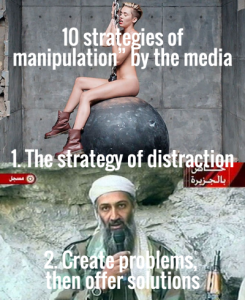
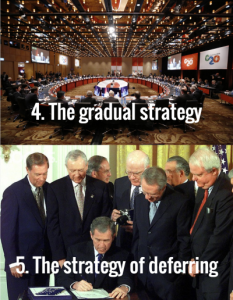 at a future sacrifice of immediate slaughter. First, because the effort is not used immediately. Then, because the public, masses, is always the tendency to expect naively that “everything will be better tomorrow” and that the sacrifice required may be avoided. This gives the public more time to get used to the idea of change and accept it with resignation when the time comes.
at a future sacrifice of immediate slaughter. First, because the effort is not used immediately. Then, because the public, masses, is always the tendency to expect naively that “everything will be better tomorrow” and that the sacrifice required may be avoided. This gives the public more time to get used to the idea of change and accept it with resignation when the time comes.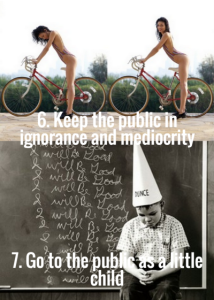 be the poor and mediocre as possible so that the gap of ignorance it plans among the lower classes and upper classes is and remains impossible to attain for the lower classes (See „ Silent Weapons for Quiet War).”
be the poor and mediocre as possible so that the gap of ignorance it plans among the lower classes and upper classes is and remains impossible to attain for the lower classes (See „ Silent Weapons for Quiet War).”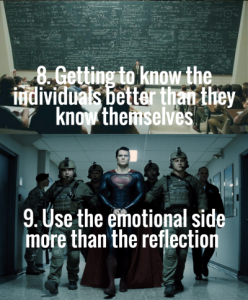 between public knowledge and those owned and operated by dominant elites. Thanks to biology, neurobiology and applied psychology, the “system” has enjoyed a sophisticated understanding of human beings, both physically and psychologically. The system has gotten better acquainted with the common man more than he knows himself. This means that, in most cases, the system exerts greater control and great power over individuals, greater than that of individuals about themselves.
between public knowledge and those owned and operated by dominant elites. Thanks to biology, neurobiology and applied psychology, the “system” has enjoyed a sophisticated understanding of human beings, both physically and psychologically. The system has gotten better acquainted with the common man more than he knows himself. This means that, in most cases, the system exerts greater control and great power over individuals, greater than that of individuals about themselves.